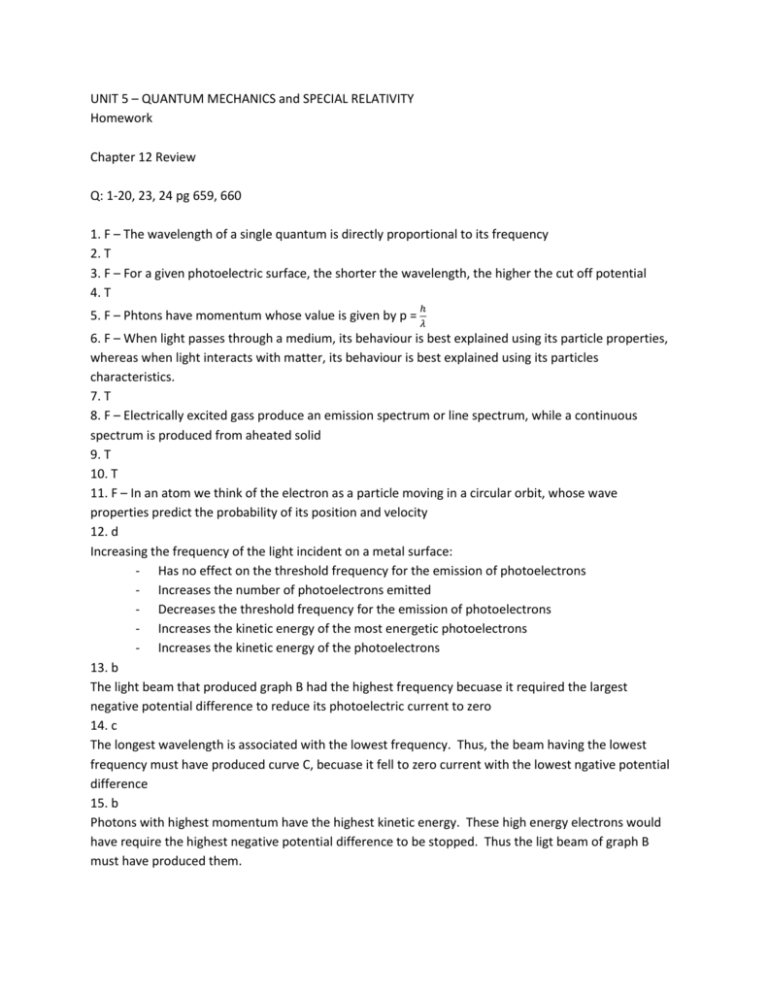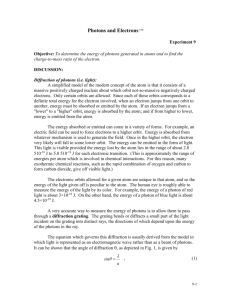UNIT 5 – QUANTUM MECHANICS and SPECIAL RELATIVITY
advertisement

UNIT 5 – QUANTUM MECHANICS and SPECIAL RELATIVITY Homework Chapter 12 Review Q: 1-20, 23, 24 pg 659, 660 1. F – The wavelength of a single quantum is directly proportional to its frequency 2. T 3. F – For a given photoelectric surface, the shorter the wavelength, the higher the cut off potential 4. T ℎ 5. F – Phtons have momentum whose value is given by p = 𝜆 6. F – When light passes through a medium, its behaviour is best explained using its particle properties, whereas when light interacts with matter, its behaviour is best explained using its particles characteristics. 7. T 8. F – Electrically excited gass produce an emission spectrum or line spectrum, while a continuous spectrum is produced from aheated solid 9. T 10. T 11. F – In an atom we think of the electron as a particle moving in a circular orbit, whose wave properties predict the probability of its position and velocity 12. d Increasing the frequency of the light incident on a metal surface: - Has no effect on the threshold frequency for the emission of photoelectrons - Increases the number of photoelectrons emitted - Decreases the threshold frequency for the emission of photoelectrons - Increases the kinetic energy of the most energetic photoelectrons - Increases the kinetic energy of the photoelectrons 13. b The light beam that produced graph B had the highest frequency becuase it required the largest negative potential difference to reduce its photoelectric current to zero 14. c The longest wavelength is associated with the lowest frequency. Thus, the beam having the lowest frequency must have produced curve C, becuase it fell to zero current with the lowest ngative potential difference 15. b Photons with highest momentum have the highest kinetic energy. These high energy electrons would have require the highest negative potential difference to be stopped. Thus the ligt beam of graph B must have produced them. 16. a The formation of these rings is similar to that produced by waves passing through a small opening and would be similar to that produced by light passing through a grating, if the grating were rotated through 360 degrees. Thus, the electrons diffraction pattern is similar to that for light, illustrating the wave nature of electrons scattered by a thin gold film. 17. e Since p2 = 2mEk, increasing the energy increases the momentum of the electrons. Since λ = h/p, increasing p decreases wavelength. For diffraction grating λ/d = sin θ, decreasing λ decreases θ, and thus decreasing the distance of the rings from the axis of the beam 18. d As the 8 eV electron collides with the atom, energy ca be absorbed as follows: 8 – 6.67 = 1.33 eV 8- 4.86 = 3.12 eV The electron could bounce off in an elastic collision, emerging with 8 eV 19. d Since the 9 eV electron has energy exceding that of all of the energy levels shown in the diagram, energies of 4.6 eV, 6.67 eV and 8.84 eV are all possible 20. e For a photon to be absorbed, it must have exactly the sam energy, as energy levels in the atom. It does not, so the atom can not be excited by a 9 eV photon 23. a For n =3, E3 = 12 eV n =2, E2 = 8 eV Eemitted photon = E3 – E2 = 12 – 8 = 4 eV 24. b The electron can transfer enough energy to the atom to raise the level from one state to another state, with a higher energy level. In this case, the only possible transistion is from n=1 (0 eV) to n =2 (8 eV). Thus, the electron transfers 8 ev to the atom and rebounds with 2 eV remaining Q: 1, 4-8, 10, 14, 19, 26, 27 pg 661 1. Visible photons are the ones our eyes can detect. A dark room is full of photons with infrared wavelength and greater, nut nore have sufficient energy to activate the nerve cells in the retina of our eyes. Therefore, we cannot see in the dark because visible light photons do not exist. There may also be photons of ultraviolet wavelengths and shorter, but these are also invisible to our eyes. 14. To analyze the composition of a gas, an absorption spectrum is used. Since the light arriving from Mars to Vnus must pass through Earth’s atmosphere, no conclusive reults are possible since Earth’s atmosphere is 20 % oxygen. 19. Water Waves Low speed Large slits Interference patterns spread over large surface Diffraction is easy to utilize Electrons High speed Very small slits (spaces between atoms) Interference pattern very small Diffraction is difficult, very short wavelengths 26. Applying the principle of uncertainty to an electron orbiting a nucleus we say that there is uncertainty in measuring the electron’s position and velocity. Thus it becomes impossible to say for any individual electron where it is now or where it will be at any future time. Rather than saying where it is, we must be satisfied with describing it slocation by starting the probability that iw will be found near any point. One way of visualizing this situation is to think of the electron existing as a cloud of negtive charge distributed around the atom, rather than as a particle moving in a circular orbit. The cloud is denser in areas of high probability and less dense in areas where the electron is less likely to be found. 27. An object can never be truly at rest. The equation ∆x∆p ≥ h/2π indicates that there is uncertainty in any measurement of position, speed, and momentum. If the position is uncertain, then the object can never be at rest, at least as we know it in classical mechanics. In reality, for macroscopic objects the uncertainty is so small that we do not notice it in normal everyday life.









